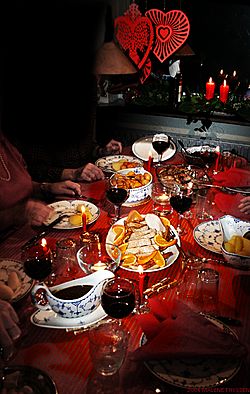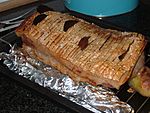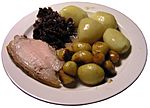Flæskesteg facts for kids

Flæskesteg with red cabbage and caramelized potatoes served for Christmas dinner
|
|
| Place of origin | Denmark |
|---|---|
| Region or state | All over Denmark |
| Main ingredients | crackling, salt, pepper, bay leaves |
Flæskesteg (say 'FLESK-uh-stye') is a popular Danish roast pork dish. Many people think it's one of Denmark's most important national foods. It always has crispy pork rind, called crackling. It's also a favorite for Danish Christmas dinner on December 24th, Christmas Eve.
Contents
History of Flæskesteg
Danes have loved pork for hundreds of years. After the Industrial Revolution in the 1860s, new wood-fired ovens came into homes. This made roast pork, along with sausages and hams, very popular.
Right from the start, the pork was cooked with its skin. This made the skin super crispy, which is called crackling. This crispy skin is still a must-have part of the dish today.
How to Make Traditional Flæskesteg
To make traditional Flæskesteg, you roast a piece of pork. This meat usually comes from the breast or neck area. You leave the skin on the meat.
Preparing the Crispy Skin
To get really crispy crackling, you need to cut the skin carefully. Use a sharp knife to make narrow cuts all the way through the skin to the meat. Then, rub salt all over the skin. Add pepper to the meat. You can also put bay leaves and sometimes cloves into the cuts.
Cooking and Serving Flæskesteg
After preparing the meat, you roast it in a hot oven. Flæskesteg is traditionally served with two kinds of potatoes. You'll have regular boiled potatoes and special caramelized potatoes.
Making Caramelized Potatoes
Caramelized potatoes are called brunede kartofler in Danish. To make them, you melt sugar in a frying pan over high heat. Then, you add a bit of butter. Small, round, peeled, pre-boiled potatoes are added to this mixture. They cook until they turn a rich brown color and become sweet and shiny.
Red Cabbage Side Dish
Red cabbage (rødkål) is always served with Flæskesteg. You can buy it ready-made in a jar or can. If you make it from scratch, people often add sliced apples to it. Many Danes believe the best traditional recipe is from Frk. Jensen's cookbook, first published in 1901.
Flæskesteg Sandwiches
Flæskesteg is also delicious served cold. It's often put on dark Danish rye bread as an open sandwich. This type of sandwich is known as smørrebrød. The thin slices of pork must have their crispy crackling. People often decorate these sandwiches with red cabbage, prunes, an orange slice, and pickled cucumber.
You can also find hot flæskestegssandwiches. These are served in a burger bun. Many Danish hot dog stands and other fast food places sell them.
See also
 In Spanish: Flæskesteg para niños
In Spanish: Flæskesteg para niños





